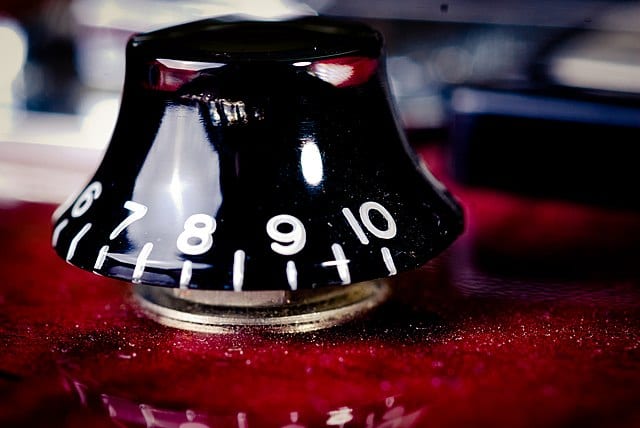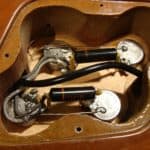Any and every guitar player in the world is likely to be familiar with the purpose and function of the tone knobs on any guitar.
However, not every guitar player will have even bothered to touch their tone knob since the day they first understood it.
Guitar tone knobs are there for a reason, however, they might not be necessary for all players. Their main function is rolling off high frequencies from the tone, so guitarists that prefer darker tones will really make use of them. For brighter sounds, tone knobs are not that useful.
Many guitarists tend to pay more attention to the tone alternating functions in the guitar including various pick-up switches, volume knobs, and a variety of split-coil switches.
What does the tone knob on an electric guitar do?
The function of the tone knob is that as it is rolled off, it begins to cut off the high frequencies going out of the guitar into your amp, and then when it is rolled back, those same exact high frequencies come back.
In simpler terms, it makes the guitar sound darker the lower the tone knob is turned. Usually, if a tone knob is labeled with numbers around it from 1 to 10, 10 tends to be the full signal whereas is 1 is the dark signal with the high frequencies cut off.
If you are familiar with music production, consider the tone knob to act exactly the same way as a high-cut/low pass EQ does. The more it is used, the darker the signal becomes.
Do players actually use the tone knobs on their guitars?
Plenty of experienced and professional players make use of the tone knobs when they are confident with adjusting the parameters to recreate the guitar tone they are after.
One example is jazz guitarists. A common practice in guitar tone for jazz players is to roll off the tone knob about halfway to achieve a warmer and darker tone to better fit the jazz style rather than having a bright spanky sounding guitar. However, jazz guitarists tend to always use a clean sound.
When it comes to other genres such as rock and metal where a distorted sound tends to be more favored over a clean sound 80% of the time, the tone knob has a lot less purpose and use as distorted guitars have a much less dynamic range compared to clean tones.
Is it ok if you don’t use the tone knob?
There is absolutely nothing wrong with making no use of the tone knob. If you are concerned about whether this lack of use diminishes your professionalism or skills as a guitar player, there is no need.
It is surprisingly common for guitarists all over the world to not use the tone knob or even think about it for that matter.
It also depends entirely on your playing style, the genre you thrive in, and what tones you are chasing for your personal library of everyday guitar sounds.
There are actually guitars known to be used for the heavier genres that do not actually come with a tone knob as it is recognized that it is not often used at all with distorted tones.
An example would be the John 5, Telecaster. Instead of the traditional two single-coil pick-ups, one volume and one tone knobs, it comes with two humbuckers (more suited for rock) and two volume knobs.
This allows a multi-purpose pick-up switch to act also as a kill-switch when one volume knob is completely rolled off while the other is at full volume, leaving one humbucker pick-up completely silent.
Why do some guitars have multiple tone knobs?
Any guitar that you find with multiple tone knobs will usually suggest that each tone knob functions as individual tone controls for each pick-up in the guitar.
The most common example would be a Fender Stratocaster, a well-known industry standard in the guitar world.
Though the traditional Stratocaster has developed over the years to have humbuckers and fewer knobs, its traditional build usually consists of 3 single-coil pick-ups (bridge, middle, and neck), one volume knob for the overall volume of the guitar, and 2 tone knobs.
One tone knob will usually control the tone of the bridge pick-up and the middle pick-up whether it’s controlling each pick-up individually or together, depending on which position the pick-up switch is at.
The other tone knob is the same exact thing but instead of the bridge pick-up, it will control the neck pick-up and the middle. Again, whether it is individually or both at the same time depending on the position of the pick-up switch.
Tips on how to use the tone knob on your guitar to enhance your tone
1. Cut off the brightness
Rolling off the tone knob about a quarter or halfway can help cut off some of the brightness.
Especially if you are using a guitar with single-coil pick-ups, the tones you would get will often sound bright and sometimes piercing. This is where the tone knob can prove useful and help the tone sit better in the context of a live band or recording.
2. Wah without a pedal
There is a technique that is not often used but is possible for those who do not own a wah pedal or for those who are not in favor of tap dancing on stage around pedals and would rather focus on the instrument.
This is only possible with a guitar that has a 5-way pick-up switch and two-tone knobs (often a Stratocaster).
The method involves turning the neck tone knob all the way down and leaving the bridge tone knob all the way up.
If the switch is pushed from neck to bridge while playing a sustained note or lick, it results in an effect similar to the way a physical wah pedal goes from a dark tone in heel position to a bright tone in toe position.
3. Create an edgy built-up atmosphere
This is another rare but incredibly effective technique. In the song ‘Money For Nothing’ by Dire Straits, there is a section where the guitar plays alone with this distorted tone that is very distinct but simple enough to capture.
It is fairly obvious that the tone knob is rolled off here because a rolled off tone knob combined with distortion is far more recognizable compared to a distorted guitar with an EQ high cut.
This use of the tone knob creates this atmosphere that instantly puts the listener on edge and suggests something is coming.
This is something that can easily be applied to other songs to recapture that same feeling and yet, even for an amateur player, it is very easy to recreate.

Hello there, my name is Ramiro and I’ve been playing guitar for almost 20 years. I’m obsessed with everything gear-related and I thought it might be worth sharing it. From guitars, pedals, amps, and synths to studio gear and production tips, I hope you find what I post here useful, and I’ll try my best to keep it entertaining also.





